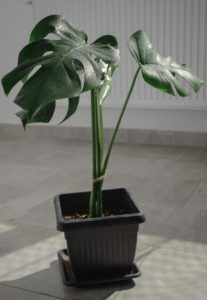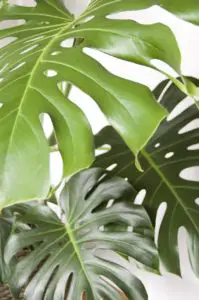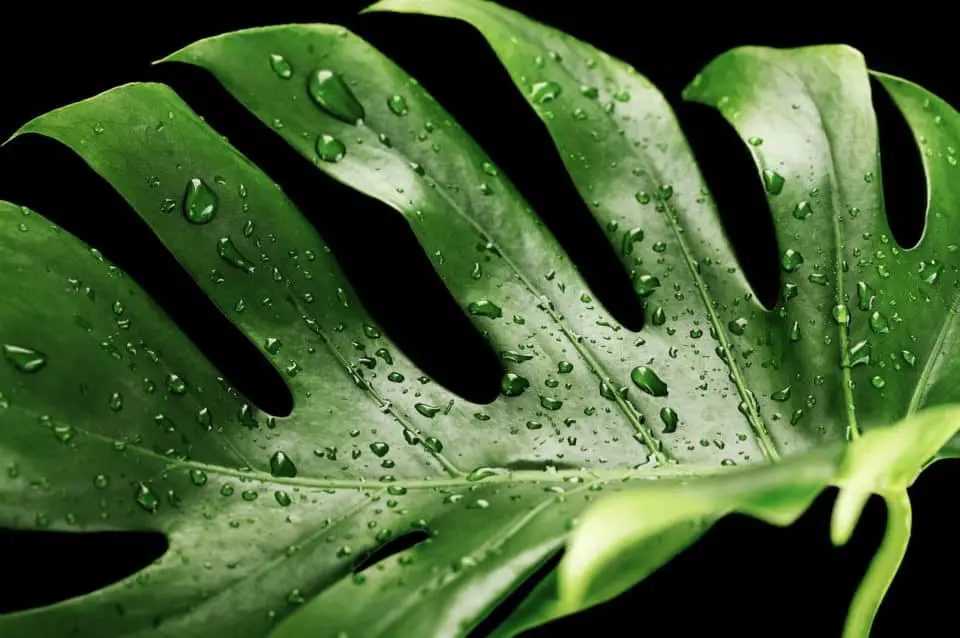Some links in the post are affiliate links and I get a commission from purchases made through some links found in the post.
Monstera belongs to species of evergreen tropical vines and shrubs native to tropical rainforests of Central America. It is a plant sought for decorating the living space.
The vibrantly green leaves speckled with natural holes provide an aesthetic outlook. The exotic-looking leaves make the plant all the more desirable.
It prefers medium indirect light, requires watering every 1-2 weeks, and survives well in normal humidity, although it prefers humid conditions to grow.
It strives well at a temperature range of 65°F-85°F and prefers a well-draining potting mix. The plant is not that prone to pests and normally does well.
Although easy-going, if not properly cared for, monstera can fall prey to pests like thrips which endanger its beauty.
What are Thrips?
 Thrips are small, slender insects with fringed wings and particular asymmetrical mouthparts. They have an elongated, transversely constricted body nearly 2mm long.
Thrips are small, slender insects with fringed wings and particular asymmetrical mouthparts. They have an elongated, transversely constricted body nearly 2mm long.
Different thrips species survive mostly by feeding on plants by puncturing and sucking up the contents, and only a few are predators.
Thrips severely damage plants during feeding on them. Thrips are tiny and hard to spot and are detected when damage to the plants they feed upon becomes noticeable.
Their fecal matter deposited on the leaves of their host plants also is a clue for thrip infestation. Trips feed on the leaves of many plants, including the prized monstera plant.
What are the Signs of Thrips on Monstera?
Adult female thrips damage the monstera leaves and plant tissue by puncturing holes in them. They then lay their eggs on the leaves.
The nymphs hatch and immediately begin to feed on the sap. When deprived of sap, the monstera plant loses the mechanism by which it distributes nutrients and water to the whole plant.
Signs of a thrip infestation:
- Check for signs of lifelessness. If your plant is getting duller and weak by the day, the thrips are likely depriving it of nutrition.
- Look for signs of yellow and brown discoloration on the leaves.
- Black spotting on the underside of leaves also indicates thrip-induced damage.
- Check the leaves for drooping, curling, and wilting.
- You can also use a magnifying glass to view thrips crawling on the underside of the leaves or the top.
If you see any of these signs on your monstera plant, resort to treatment and preventive measures.
You may also like: How to care for a monstera
How to Get Rid of Thrips on Monstera?
There are many ways in which to get rid of thrips that have inhabited your monstera plant. These include:
1) Using Bug Traps
Many insects are attracted to yellow, blue, and white colors, including thrips. Using this to your advantage, you can install colored bug traps near your monstera plant.
The thrips would be attracted to the trap and get stuck on it. Gradually all the thrips would fall prey to your trap, leaving your plant bug-free.
The bug traps can be bought from a store but can also be made at home using a piece of colored paper and sticky glue or honey.
2) Removing Thrips Manually or by Lint Roller
You can also remove thrips manually from your plant if visible enough one by one, or you can use a lint roller.
Gliding the lint roller on your plant’s leaves would capture the thrips due to the roller’s adhesive nature.
3) Killing Thrips by Insecticide
Many insecticide soaps are available in the market made up of potassium fatty acids known for their ability to break the shell of the thrips on contact, penetrating the bud, dehydrating it, and causing it to die.
Thus using insecticide soaps is a means to kill the thrips. The thrips would then fall off or can be removed by washing.
While using an insecticide soap, keep in mind to water your plant before spraying and spray the plant during the night to avoid the mix from drying too quickly.
Also, make sure to do a patch test to ensure that the insecticide soap spray does not burn or damage the leaves of your monstera plant.
4) Using Natural Predators of Thrips
An environmentally friendly way of removing thrips from leaves is the introduction of natural predators of thrips to the plant to eat the thrips without harming it.
This is an easy way but may take some time. One such natural predator used commonly to remove thrips is ladybugs. The ladybugs feed on the thrips without harming your precious plant.
5) Trimming Damaged Leaves
Try pruning or trimming the damaged leaves of your monstera plant once you have eliminated the thrips. Removal of the damaged leaves promotes accelerated new growth.
Can Monstera Recover from Thrips?
Recovery from a thrip attack is based on how much damage has been caused by the insect.
1) Recovery When There is Minimal Damage
 Early detection is key. If you have identified the thrip infestation when the thrips haven’t caused much harm to the plant, then your monstera can recover easily in no time.
Early detection is key. If you have identified the thrip infestation when the thrips haven’t caused much harm to the plant, then your monstera can recover easily in no time.
After removing the thrips, give your monstera adequate temperature, humidity, sunlight, water, and fertilizer, and it will start growing back in its healthy form quickly.
2) Recovery When There is Partial Damage
If part of your plant is damaged while the rest is damage-free, you can preserve the healthy part, wash it, ensuring no thrips are present, and propagate a new whole plant from the cuttings.
3) Recovery from Extensive Damage:
Unfortunately, if your plant has been damaged too much by thrips, it appears heavily and extensively discolored and is incapable of survival.
It is better to discard the plant to prevent the infestation from spreading to your neighboring healthy plants.
How to Stop Your Monstera getting Thrips in the Future?
Although it is quite resistant to pests, to prevent it from getting any household and unusual insect attacks, you should follow the following preventative measures:
1) Isolate New Plants
If you’ve already had a thrip outbreak infecting your plants, make sure to keep the recovered and infected ones away from your newly purchased healthy plants to avoid them from getting a similar disastrous fate like the former greens.
2) Maintain Cleanliness
Dirty and dusty leaves are an easy target for thrips as well as other kinds of pests. Therefore it is essential to keep your plant healthy, fresh, and free from pests.
Also, make sure you clean off the dirt or wash it lightly regularly. This is not only for prevention but also to make your plant stand out.
3) Use Neem Oil
Neem oil is a natural pesticide that does not harm plants. It works to suffocate and prevent insects. You can use neem oil in a liter of water mixed with liquid soap to spray.
Always remember to patch test an area of the plant to know the soap is not overpowering and damaging to it.
You can apply the spray to every part of the plant generously and then let the spray dry.
The neem oil will form a protective layer on your plant that prevents thrips. Neem oil spray lasts for about two days on your plant.
We also have an article on does neem oil kill spider mites.
4) Remove Weeds on Soil
Weeds are damaging to the plant and provide room and shelter from thrips to survive and nourish.
Once grown to adult form, the thrips can then crawl up your monstera plant and damage it, depriving it of essential nutrients.
5) Keep your Plant Healthy
A healthy plant is quite resistant to pests itself. If your plant is already weak and damaged, it is more likely to get a thrip attack, further causing it to wither and wilt.
Therefore to save your plant from not only thrips but other kinds of pests and fungi, it is necessary to keep it healthy, provide it adequate growing conditions, nourish it with fertilizer helping it to thrive better and stay strong
Final Thoughts
 Monstera is a lovely plant that is known for its beautiful holed leaves and aesthetic appearance. Although hardy, it can fall prey to thrips if it is weak.
Monstera is a lovely plant that is known for its beautiful holed leaves and aesthetic appearance. Although hardy, it can fall prey to thrips if it is weak.
Thrips are winged insects that damage many household plants, including monstera. Don’t worry too much because there are ways to remove pests from your monstera using adhesives and insecticides.
Prevention is better than cure, so using neem oil, keeping the plant healthy, and isolating new plants is the way your plants could remain safe from pesky thrips.
About the Author:
Saad Ansar
Saad is an avid gardener himself and is a great lover of plants, animals, photography, & people. Currently, he is focused on photographing indoor plants & captioning beautiful outdoor sceneries. He writes and rewrites in-depth articles on nature and science.

